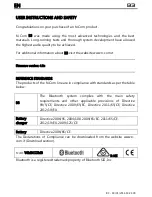
Chevrolet Captiva Owner Manual (GMNA-Localizing-MidEast LHD-
14860584) - 2021 - CRC - 5/18/20
126
Driving and Operating
Small braking friction sounds and friction
sounds between tires and the ground are
normal and no special treatment is needed.
It is also normal that occasional squeals are
given in braking. Squeals may be produced
for such causes that other matters may
adhere to the brake pads during operation
of the vehicle, the vehicle is out of
operation for a long time, or brake pads get
rusted after raining. If squeals are produced
at a lower frequency, there is no need for
special treatment.
To avoid the pedal travel from being
affected, do not lay a thick carpet in the
brake pedal area.
If the brake pedal fails to return or the
brake pedal travel becomes longer, this may
indicate a faulty brake system.
When you drive your vehicle in a
high-altitude area, continuously braking may
cause the brake pedal force to increase.
To ensure proper brake system performance
when the vehicle is new or after installing
new brake pads, avoid emergency braking or
extended braking within the first 200 km.
{
Warning
After driving through deep water,
washing the vehicle, or using the brakes
excessively when going down a steep hill,
the brakes can temporarily lose their
stopping power. This may be due to wet
brake components or overheating.
If your brakes temporarily lose their
stopping power because of overheating:
Shift to a lower gear when going down
hills. Do not continuously apply the
brakes.
If your brakes temporarily lose their
power because of wet brake components,
the following procedure will help restore
their normal performance:
1. Check behind you for other vehicles.
2. Keep a safe forward speed with
plenty of space to your rear and
sides.
3. Gently apply the brakes until normal
performance is restored.
If the brake system is unable to brake
temporarily due to overheating, engage a
lower gear when driving downhill and use
the engine to brake.
If the brake system is unable to brake
temporarily due to wet components, the
normal performance can be recovered:
1. Check whether there are vehicles behind
your vehicle.
2. Keep a safe driving speed to ensure
there is sufficient space behind your
vehicle and at both sides of your vehicle.
3. Carefully press the brake pedal until the
normal performance is recovered.
Electronic Brake-Force Distribution (EBD)
The Electronic Brake-Force Distribution (EBD)
system uses the high-speed computer to
respectively induce and calculate different
ground to which four wheels are attached,
and thus calculate different friction values at
the moment the vehicle brakes. Therefore,
four wheels can brake in different ways and
force based on different conditions, and can
be adjusted fast during movement, to
ensure that the vehicle is stable and safe.
















































